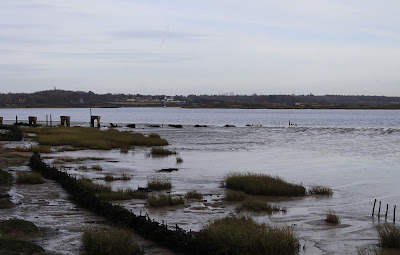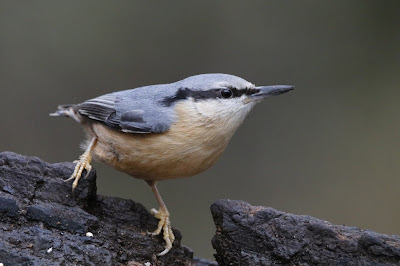Where do you go when you have exhausted all the bird reserves in Suffolk? You head down to Essex. Our southern neighbour has some great reserves. Sure it doesn't have the reedbeds or heathland like Suffolk, but it has lots of other wetlands, reservoirs, grazing marsh and tidal estuaries. It was to a reservoir that I would go to today, Abberton Reservoir, one of the largest and best in the country.
GREAT WHITE EGRET
Reservoirs like Abberton are absent in Suffolk. Yes there is Alton Water (see some of my blogs) but there is no comparison between the two places bird wise. However like Alton Water, Abberton is difficult to view. Abberton is a ginormous reservoir with vast numbers of wildfowl, but the only viewing is from the small reserve, a little promenantory into the water, and two causeways, Layer-de-la-Haye and Layer Breton.
The GREAT WHITE EGRET are noticeably taller than the HERONS
To emphasise the sheer scale of wildfowl at Abberton, in the bay next to the visitors centre there was roughly two and a half thousand TEAL. That's quite a lot of duck, they made a large concentration, many black dots on the water. Amongst them was a large raft of POCHARD and TUFTED DUCK, with smaller numbers of GOOSANDER. More excitingly there were also two LONG TAILED DUCK just off the concentration. Now this sea faring duck is rare inland, more akin to the coasts of Scotland like the Moray Firth than inland Essex.
As I was watching them a MARSH HARRIER flew over, causing a bit of commotion, but ducks have learnt to not fear this raptor.
Male GOLDENEYE amongst female TUFTIES
On the main reservoir, ducks were mainly in small flocks, of single figure, the species most represented were GOLDENEYE, there must have been several hundred present. Large rafts of duck were seen in the distance but due to the vastness of the water I couldn't tell what they were, even through a telescope. It was almost like an inland sea.
Male TUFTED DUCK
Hide Bay was another area looked over from the nature reserve. Although duck numbers here were fairly low, what it did have were an amazing ten GREAT WHITE EGRET. This is the largest concentration I have ever see of this species, and provided some great photo opportunities. I was really worried that with the vastness of the reservoir, there would be no nearby birds to photograph, but little did I have to worry when this species was present.
Also amongst them was a tiny GREEN SANDPIPER, it was so small it seemed like one of the egrets would tread on him.
Male and female GOOSANDER. They breed in northern rivers, wintering south on reservoirs like Abberton
The reserve at Abberton is fairly new, with recently planted trees, so there wasn't very much birdwise, except a flock of FIELDFARES. A large amount of trees have been planted so in fifty years it will be great for birds, a shame I doubt I will live to see it. Recent construction work has resulted in the old concrete banks being removed to reveal muddy margins which has greatly enhanced wildfowl numbers. One of the few times where development has benefitted wildlife.
Some of the many TEAL
Layer-de-la-Haye causeway looked over the visitor centre bay, providing a different angle to the vast flock of ducks found there. On the otherside of the causeway was a flock of around a hundred SHOVELLER as if just to emphasise how many birds were present.
Layer Breton causeway is much further south. Here the landscape is more natural, with trees and reeds providing the surroundings. Numbers of ducks here were much smaller with nothing out of the ordinary, what you would expect from a normal body of water.
Fingringhoe Wick
Fingringhoe is a nice little Essex Wildlife Trust reserve, a quarry overgrown with scrub that provides views over the tidal River Colne. Having spent a long time at Abberton, I only had an hour to spend here, needing to beat the rush hour traffic home.
The view of the mudflats from Robbie's Hide
I concentrated on the more southern hides which provided the best views over the mudflats. The tide was coming in quick, and there was only a small amount of mud exposed. Most noticeable was a flock of around 500 KNOT packed tightly into the water's edge. There were also flocks of DUNLIN, as well as single CURLEW, BLACKWIT, GREY PLOVER and OYSTERCATCHER amongst them. There were few duck, some SHELDUCK, WIGEON, whilst a small flock of BRENT GEESE flew north. On the river, on the deeper water were several RED BREASTED MERGANSER.
The light became pretty terrible at Fingringhoe, so this was the best I could get.
From Crawshaw Hide, overlooking a little scrape in the saltmarsh, I saw a WATER RAIL, as usual the bird was very nervy about being even slightly out in the open and was only viewed a few times, seen through the reeds.
I visited Crawashaw, Geedon Bay and Robbie's hides. After visiting those hides, rather than head north, I walked the inner part of the reserve, through a mixture of scrub and young woodland, round the lakes at the centre of the reserve. Out on the lakes there wasn't much apart from small numbers of the usual ducks.
As I returned to the car the water had completely covered the mud flats the power of natural forces at work.
So a rare visit over the border to Essex really came up trumps, with some decent birds on show today. As always there's not enough time, especially in winter, to visit them properly. There are a lot of good reserves in Essex, lots of birds to see, so I recommend a visit sometime.


















































